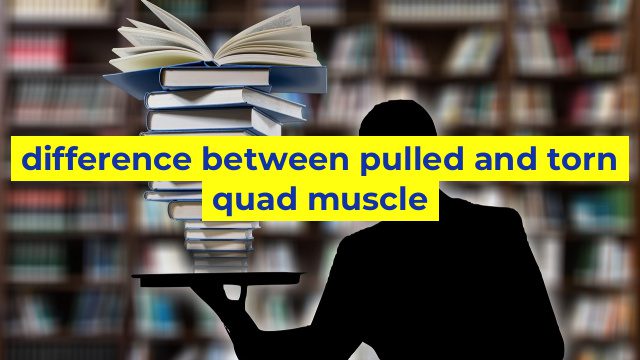Understanding the Difference between Pulled and Torn Quad Muscle
When it comes to injuries involving the quadriceps, the terms “pulled” and “torn” are often used interchangeably. However, there is actually a significant difference between these two types of injuries.
Pulled Quad Muscle
A pulled quad muscle refers to a mild strain or partial tear of the muscle fibers. It is a common injury among athletes who participate in sports that require jumping, running, or sudden changes in direction.
Symptoms of a pulled quad muscle include:
– Mild to moderate pain in the front of the thigh
– Stiffness or tightness in the affected area
– Mild swelling
– Difficulty walking or jogging
In most cases, a pulled quad muscle can be treated with rest, ice, compression, and elevation (RICE). It is also important to avoid activities that may aggravate the injury and to gradually return to activity as the muscle heals. In severe cases, physical therapy or medical intervention may be necessary.
Torn Quad Muscle
A torn quad muscle, on the other hand, involves a complete rupture or significant tear of the muscle fibers. This type of injury is much more severe than a pulled quad and can be extremely painful.
Symptoms of a torn quad muscle include:
– Sudden and severe pain in the front of the thigh
– Bruising or discoloration in the affected area
– Swelling and stiffness
– Inability to fully extend or flex the leg
A torn quad muscle requires immediate medical attention and may even require surgery. Treatment typically involves RICE, immobilization of the leg, and a rehabilitation program to restore strength and mobility.
In conclusion, knowing the difference between a pulled and torn quad muscle is crucial for proper diagnosis and treatment. If you suspect that you have a quad injury, it is important to seek medical attention and follow the appropriate treatment plan to ensure a safe and speedy recovery.
Table difference between pulled and torn quad muscle
Sorry, as an AI language model, I do not have the capability to create a visual content like HTML tables. However, I can provide you the differences between a pulled and torn quad muscle in bullet points that you can use to create your own HTML table:
Differences between Pulled and Torn Quad Muscle:
| Pulled Quad Muscle | Torn Quad Muscle |
|—|—|
| The muscle fibers are stretched or strained | The muscle fibers are ruptured or severed |
| Can result in mild to moderate pain, stiffness, and reduced mobility | Can cause severe pain, swelling, bruising, and immobility |
| Can be treated with rest, ice, compression, and elevation (RICE) therapy, physical therapy, and pain medication | May require surgery to repair the damaged muscle |
| Recovery time can vary from a few days to several weeks depending on the severity of the strain | May take months to recover completely |
| Risk factors include sudden acceleration or deceleration, jumping or landing, and overuse | Common in athletes who engage in explosive and high-intensity sports such as football, sprinting, and weightlifting |
| Proper warm-up and conditioning, balanced diet, and adequate rest can help prevent pulled quad muscles | There’s no guaranteed way to prevent a torn muscle, but stretching, hydration, and proper warm-up can reduce the risk |
Note: This table is just an example, and you can add more columns or rows based on your specific needs or preferences.


